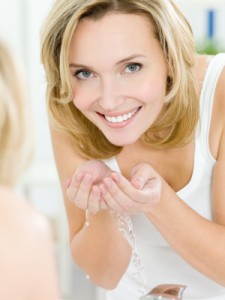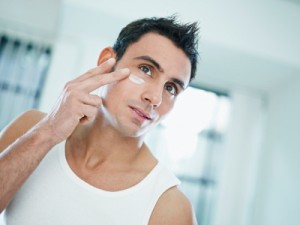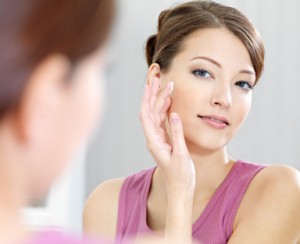There are four simple steps to consider in caring for you face: cleansing, treating special problems, moisturizing, and protection. These steps should be repeated morning and night.
Step 1: Cleansing
 Simplicity is the key here. You need to find a good cleanser that your skin responds well to, and stick with it. There are excellent cleansers available in all price ranges. Just because one is more expensive than another does not mean that it is better for your skin.
Simplicity is the key here. You need to find a good cleanser that your skin responds well to, and stick with it. There are excellent cleansers available in all price ranges. Just because one is more expensive than another does not mean that it is better for your skin.
Skin cleansing should be done every day as it removes oils, dirt, makeup, and dead skin cells from the surface of the face. Water alone is not enough to rinse the unwanted debris from your face. When you pour vegetable oil and water in a glass, the oil just sits on top of the water. Similarly, if you just splash your face with water, the oils remain on the skin because the oil and water do not mix.
Skin cleansers are made of surfactants. Surfactants are substances that have two parts: a hydrophilic, or water-loving, end and a hydrophobic, or water-repelling, end. The water-resistant end of the detergent molecules is attracted to the oils on the skin and surrounds them. The water-loving end of the detergent enables the dirt to be washed away since it is attracted to the water you splash on your face. The surfactant also helps water to be spread more easily on the skin.
Soaps are commonly used as cleansers. They are formed by mixing fats or oils with an alkali substance (an alkali is the opposite of an acid). Because soaps are sometimes too drying to the skin, synthetic detergents, syndets, are often used. These syndets are used in combination with other ingredients to give the product the characteristics you desire.
So, ingredients to moisturize the skin, to help the cleanser lather more, to smell good, or to achieve the desired color are added to a detergent to make the final product. Other ingredients may be added to increase the stability of the formula, or to discourage bacterial growth.
Anionic, or negatively charged, surfactants are commonly used in the skin care products. Sodium laurel sulfate is often used because, in addition to being a good cleanser, it has pleasing foaming qualities and is stable and easy to formulate. Sodium laureth sulfate and sodium sulphosuccinate are other ingredients you might see in your cleanser.
Anionic surfactants can be irritating to sensitive skin and should be avoided. Amphoteric surfactants are less irritating than anionics, and include sodium laurimino dipropionate and cocamido proply betaine. Moisturizers such as glycerine or lanolin may be added to the cleanser. They give the most moisture after the skin has been washed.
Cold creams are thick cleansers that include moisturizing ingredients. They are useful for cleansing dry skin and also for removing makeup. They are made of ingredients such as mineral oil or petrolatum. They are not appropriate for people with oily or acne-prone skin.
Exfoliators removed dead skin cells from the surface of the skin to reveal the more lustrous skin beneath. Exfoliating can be useful for people with dry skin and also for people with acne-prone skin because it can help to unblock the pores. One method of exfoliating uses chemicals to increase the rate of cell turnover and make the skin cells easier to remove. A second method uses a mechanical action to scrub away the dead skin cells.
Chemical exfoliants include retinols, alpha-hydroxy acids such as glycolic acid and lactic acid, and beta-hydroxy acids such as salicylic acid. These ingredients are found in many over-the-counter products. They are available in higher concentrations in products available through a dermatologist’s office. Some of these agents are also for chemical peels.
Mechanical exfoliants include natural products such as ground fruit pits or almond shells, sugar, or salt added to a cleanser. Other ingredients used are aluminum oxide crystals, like those used in microdermabrasion, or polyethalene beads. Pumice is used on the feet but is too rough for other parts of the body.
Instead of looking for a product with an exfoliator in it, you can exfoliate by using any cleanser applied to a bath sponge, loofah, brushes, or microfiber cloth.
Toners are intended for use after cleansing and before moisturizing. They are meant to provide additional attributes, such as moisturization or drying. Toners for oily skin contain acohol, which removes any sebum or debris left behind by cleansing. If a toner is too strong, oily skin will be dry for a short time but will respond with a rebound oiliness within a few hours.
Toners for dry skin do not contain alcohol. They may contain glycerine instead. Glycerine is a humectant, which holds water in and helps to moisturize the skin.
| - | Make a paste using oatmeal and warm water to gently exfoliate dry or irritated skin. |
| - | Mix equal parts of sea salt and an oil like almond oil, olive oil, or baby oil to make a coarse scrub for the body skin. |
| - | Combine one teaspoon of baking soda or cornmeal in your favourite liquid facial cleanser for a mild weekly facial scrub. |
| - | Add sugar to honey or oil for a gentle, skin-softening scrub. |
| - | Coffee grounds can be mixed into the oil of your choice for a skin smoothing scrub. |
Step 2: Treating
At different times in your life, there will be areas of your facial skin that will require special attention. Whether you need to clear up a pimple, get rid of a dark spot or reduce redness, applying products to address these special needs is usually best performed between cleansing and moisturizing so that the treatment comes directly in contact with the skin, and absorption is not delayed or reduced by the moisturizer.
Of course, the application of prescription medication for conditions like adult acne, rosacea, and seborrheic dermatitis on the face take precedence over the use of over-the-counter treatments.
Fade creams are used all over the world, by millions of individuals to lighten unwanted discoloration, even out the pigmentation of their skin, or just brighten the skin. Creams used to fade dark spots or even the complexions are known by many different names, among them fade creams, lightening creams, and evening creams.
In some countries the term “whitening creams” is used, but in other countries this term is considered racially charged. In the United States, use of the term “bleaching cream” is limited to products containing hydroquinone. Hydroquinone is a chemical that is effective in decreasing pigmentation in the skin.
It has become a source of controversy in the cosmetic and medical communities in recent years. This is because some evidence indicates that hydroquinone may be carcinogenic in laboratory animals. It has not been shown to be carcinogenic in humans, though it has been in use for several decades. The main side-effect of hydroquinone in humans is a condition called exogenous ochronosis: an unwanted grey, brown, blue or black pigmentation occurs in the skin, making it darker rather than lighter.
The risk of ochronosis seems to be higher when the concentrations of the product are used or when it is used for a long time. Hydroquinone is available in over-the-counter products in concentrations of up to 2 percent in the United States, but physicians can prescribe higher concentrations.
Because of the controversy surrounding hydroquinone, the cosmetics industry has searched for other ingredients effective in lightening the skin. Ingredients containing arbutin are widely used. Arbutin is found in the extracts of bearberry, mulberry, cranberry, and blueberry. Licorice extract contains glabridin, another effective ingredient.
Vitamin C also reduces pigmentation, and alpha-hydroxy acids and retinoids increase the skin’s cell turnover and reduce the time a dark spot is present. Mequinol is available as a prescription in combination with the retinoid tretinoin. Some ingredients are controversial. Glutathione is a common ingredient in skin lightening products in some countries, but its effectiveness has not been demonstrated.
Kojic acid is considered to be an effective ingredient. Its use in products is limited by concern about potential carcinogenicity and by challenges about its stability and like hydroquinone, it has been banned in some countries.
Skin serums are aimed at treating specific problems. They are characteristically light-weight liquids that contain active ingredients. The fact that they are not heavy allows you to layer on more than one serum to create a very customized skin care regimen, and makes them appropriate for use under your moisturizer or makeup.
The active ingredient is usually a key selling point for these products since they are geared towards being effective and results-driven. Some serums serve to hydrate the skin. Others plump the skin to minimize the appearance of fine lines. Glycolic acid is one of the ingredients commonly found in exfoliating serums.
Antioxidants are often found in antiaging serums. Collagen and peptides are other ingredients that are currently popular to add to these products.
Eye creams provide moisture to the delicate eyelid skin. There are creams available that claim to treat puffiness, dark circles and wrinkles. The truth of the matter is that some of these preparations provide better results than others, but there is truly no miracle cream.
Eye creams contain many of the same ingredients that facial moisturizers do, but often in lower concentrations in order to minimize the risk of irritation. Common ingredients include antioxidants like vitamin C, exfoliants like glycolic acid, skin renewing substances like retinol and peptides.
Lip treatments can provide you with soft, kissable lips. How do you keep yours pucker-ready? Start by exfoliating. When you brush your teeth, gently brush your lips with your toothbrush to remove dead skin cells. Your lips are then ready for whatever product you choose.
Most lip plumpers are really just mild irritants which cause blood flow to the lips to increase. You may also get a slight stinging sensation that accompanies application. Lip balms can help to seal in moisture, and some contain sunscreens to protect the lips from the sun.
Natural Toners
Several natural products make excellent toners. You may have these items around the house:
- Witch hazel used alone
- Tea tree oil mixed with witch hazel
- Lemon juice diluted in water
- Rose petals steeped in boiling water and allowed to cool
- Apple cider vinegar diluted in water
Step 3: Moisturizing
 Moisturizers are used to keep the skin hydrated. It is important to apply your moisturizer immediately after cleansing and treating the skin, while it is still damp. This maximizes the effectiveness of the moisturizers by “sealing” the water in the skin before it has a chance to evaporate. Three main types of ingredients are used in moisturizers.
Moisturizers are used to keep the skin hydrated. It is important to apply your moisturizer immediately after cleansing and treating the skin, while it is still damp. This maximizes the effectiveness of the moisturizers by “sealing” the water in the skin before it has a chance to evaporate. Three main types of ingredients are used in moisturizers.
Humectants attract water to the epidermis. This water may come from the dermis or from the environment.
Occlusive ingredients coat the skin to prevent moisture loss through evaporation, trapping water in the skin.
Emollients leave the skin feeling soft and smooth. Some ingredients serve more than one of these functions, and many commercially available moisturizers contain two or more moisturizing ingredients.
Cyclomethicone and dimethicone are used in products for people with oily skin because these products are silicone-based and thus are not oily. Ingredients used in heavier moisturizers for people with dry skin include mineral oil, petrolatum, and paraffin. Lanolin is used sometimes but may be irritating to sensitive skin. There are other effective ingredients that may be used in moisturizer. These are just a few of the most common ones.
Step 4: Protection
It is vital to protect your skin from the harmful rays of sunlight. It is best to wear sunscreen every day, all year around to help reduce the development of wrinkles, blotchy skin discoloration, and most importantly, to decrease your risk of getting skin cancer.
Sunscreens provide protection from the effects of the sun’s ultraviolet rays on the skin. These rays are categorized by their wavelength. Ultraviolet A (UVA) rays are longer and have wavelengths of 320-400 nm. Ultraviolet B (UVB) rays are shorter and have wavelengths of 290-320 nm. There are ultraviolet C rays, but they do not penetrate the ozone layer.
The sun protection factor of a sunscreen gives an indication of how well a particular product protects you from UVB rays. The numerical value tells you how many times longer you can stay in the sunlight without burning compared to if your skin was unprotected.
For instance, if you can normally stay in the sunlight for 10 minutes without burning, by putting on a sunscreen with an SPF of 30 you could stay in the sunlight for 300 minutes, or 5 hours, without burning. It is important to note that these values are determined in a controlled, laboratory setting. In real life, sunscreen needs to be applied every two hours and every time you get out of the water, even if it is waterproof.
Currently there is a rating system to measure protection from UVA rays. Most products recognize this feature as desirable and include their UVA protection on the label. Several ingredients provide effective protection against sunlight.
Titanium dioxide and zinc oxide reflect and scatter the sun’s rays away from the skin. They are sometimes referred to as “physical blockers.” These ingredients protect against both UVA and UVB rays. They are particularly good ingredients for people with sensitive skin because they tend to be less irritating than some of the UV-absorbing sunscreens.
The main disadvantage of these products is that they can leave the skin with a chalky appearance. Other ingredients work by absorbing the sun’s rays. They are sometimes called “chemical blockers.” Ingredients you can look for that absorb UVA rays include the following: avobenzone (parsol 1789), dioxybenzone (benzophenone-8), ecamsule (mexoryl), meradimate, which was formerly known as menthyl anthranilate (neo heliopan MA), and oxybenzone (neo heliopan bb).
Ingredients effective against UVB include paba, homosalate (hms), octyl methoxycinnamate (parsol mcx, escalol 557) octyl salicylate (escalol 587), padimate o (escalol 507), phenylbenzimidazole sulfonic acid (eusolex 232, parsol hs), and trolamine salicylate.
Ingredients effective against both UVA and UVB include octocylene escalol 597, cinoxate, and sulisobenzone (ums 40).
The proper application of sunscreen is essential regardless of the brand you choose. Sunscreen should be applied in an even layer over the skin’s entire surface and must be reapplied every two hours. As mentioned previously, it also needs to be reapplied every time you get out of the water.
| What are you willing to do in order to maintain your appearance? Some people want to stick to the basics, while others want to go all out. Here are the no-nonsense nuts and bolts of what works to slow or reverse the appearance of aging. Let your own desires, comfort level, and budget help you decide what is right for you. |
| BEHAVIORAL ADJUSTMENTS |
| - Protect your skin from the sun every day using hats, protective clothing, and sunscreen. |
| - Stop smoking; if you are not a smoker, don’t start. |
| - Develop and maintain a daily routine that includes morning and evening skin care. |
| PROPER NUTRITION |
| - Drink at least 4 pints (2 litres) of plain water every day. |
| - Eat a diet rich in antioxidants, including fruits like berries, grapes, and tomatoes and vegetables like broccoli, spinach, and carrots. |
| - Make sure that you are getting enough vitamin D from food sources, or take a supplement. |
| OVER-THE-COUNTER SKIN CARE |
| - Find a gently, effective cleanser that is not irritating. |
| - Treat skin problems promptly. |
| - Moisturize as needed. |
| - Wear sunscreen with UVA and UVB protection, at least SPF 30. |
| PRESCRIPTION MEDICATION |
| - Retinoids including tretinoin, adapalene, and tazarotene are proven to improve the quality of the skin by thickening it, increasing collagen production, and smoothing the surface. Ask your doctor if a prescription is appropriate for you. |
| YOUTH-PRESERVING MEDICAL PROCEDURES |
| - Chemical peels even the color of the skin and smooth it surface. |
| - Botox injections freeze the wrinkles that come from facial expression. |
| - Dermal fillers correct deep wrinkles. |
| - Laser treatments even the texture and color of the skin and can provide skin tightening. |
| PLASTIC SURGERY |
| - Blepharoplasty will give your eyes a rested, refreshed look. |
| - Face lift is still the gold standard for the most dramatic removal of wrinkles and sagging skin. |



